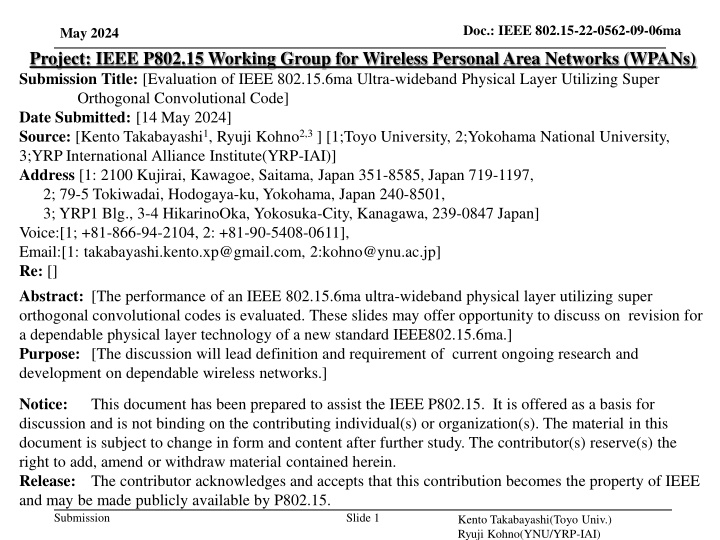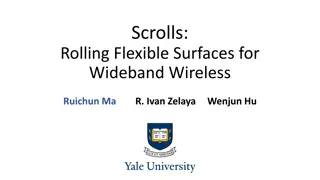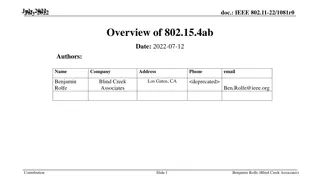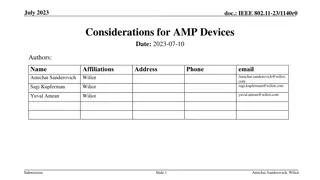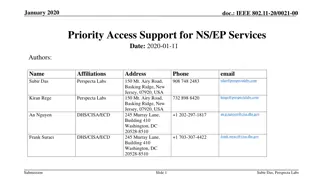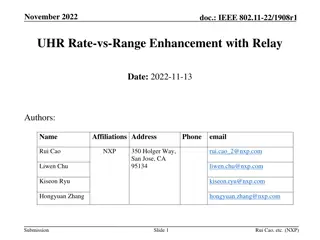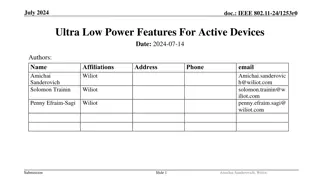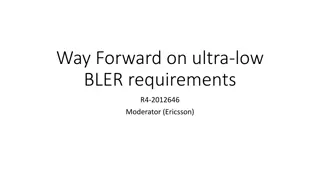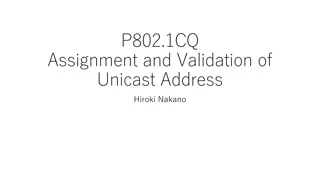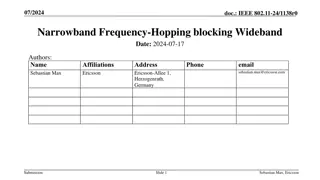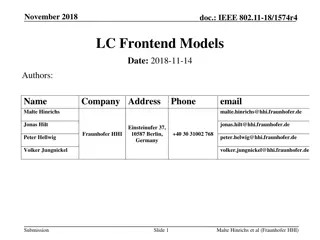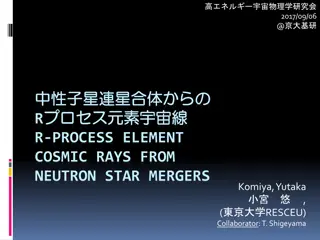Evaluation of IEEE 802.15.6ma Ultra-wideband Physical Layer
The evaluation of IEEE 802.15.6ma ultra-wideband physical layer utilizing super orthogonal convolutional codes for dependable wireless networks. Discussion on new standard IEEE802.15.6ma and the effectiveness of Super Orthogonal Convolutional Codes (SOCC) to improve dependability. Application and evaluation of SOCC at IEEE 802.15.6 UWB PHY for higher priority cases.
Download Presentation

Please find below an Image/Link to download the presentation.
The content on the website is provided AS IS for your information and personal use only. It may not be sold, licensed, or shared on other websites without obtaining consent from the author.If you encounter any issues during the download, it is possible that the publisher has removed the file from their server.
You are allowed to download the files provided on this website for personal or commercial use, subject to the condition that they are used lawfully. All files are the property of their respective owners.
The content on the website is provided AS IS for your information and personal use only. It may not be sold, licensed, or shared on other websites without obtaining consent from the author.
E N D
Presentation Transcript
Doc.: IEEE 802.15-22-0562-09-06ma May 2024 Project: IEEE P802.15 Working Group for Wireless Personal Area Networks (WPANs) Submission Title: [Evaluation of IEEE 802.15.6ma Ultra-wideband Physical Layer Utilizing Super Orthogonal Convolutional Code] Date Submitted: [14 May 2024] Source: [Kento Takabayashi1, Ryuji Kohno2,3] [1;Toyo University, 2;Yokohama National University, 3;YRP International Alliance Institute(YRP-IAI)] Address [1: 2100 Kujirai, Kawagoe, Saitama, Japan 351-8585, Japan 719-1197, 2; 79-5 Tokiwadai, Hodogaya-ku, Yokohama, Japan 240-8501, 3; YRP1 Blg., 3-4 HikarinoOka, Yokosuka-City, Kanagawa, 239-0847 Japan] Voice:[1; +81-866-94-2104, 2: +81-90-5408-0611], Email:[1: takabayashi.kento.xp@gmail.com, 2:kohno@ynu.ac.jp] Re: [] Abstract: [The performance of an IEEE 802.15.6ma ultra-wideband physical layer utilizing super orthogonal convolutional codes is evaluated. These slides may offer opportunity to discuss on revision for a dependable physical layer technology of a new standard IEEE802.15.6ma.] Purpose: [The discussion will lead definition and requirement of current ongoing research and development on dependable wireless networks.] Notice: discussion and is not binding on the contributing individual(s) or organization(s). The material in this document is subject to change in form and content after further study. The contributor(s) reserve(s) the right to add, amend or withdraw material contained herein. Release: The contributor acknowledges and accepts that this contribution becomes the property of IEEE and may be made publicly available by P802.15. This document has been prepared to assist the IEEE P802.15. It is offered as a basis for Submission Slide 1 Kento Takabayashi(Toyo Univ.) Ryuji Kohno(YNU/YRP-IAI)
Doc.: IEEE 802.15-22-0562-09-06ma May 2024 Evaluation of IEEE 802.15.6ma Ultra-wideband Physical Layer Utilizing Super Orthogonal Convolutional Code May 2024, Hybrid Session , Marriott Warsaw - Warsaw, Poland Kento Takabayashi1, Ryuji Kohno2,3 1. Toyo University, Japan 2. Yokohama National University, Japan 3. YRP International Alliance Institute, Japan Submission Slide 2 Kento Takabayashi(Toyo Univ.) Ryuji Kohno(YNU/YRP-IAI)
Doc.: IEEE 802.15-22-0562-09-06ma May 2024 Motivation and Aim of study UWB is a promising technology that may satisfy the requirements of IoMT IEEE 802.15.6 UWB PHY has limited transmission output and requires to ensure dependability New consideration is given to the application of Super Orthogonal Convolutional Codes (SOCC) as a technique for improving dependability for higher priority case We perform evaluation when SOCC is applied at the IEEE 802.15.6 UWB PHY, and confirm the effectiveness of these combinations Submission 3 Kento Takabayashi(Toyo Univ.) Ryuji Kohno(YNU/YRP-IAI)
doc.: IEEE 802.15-22-0562-09-06ma May 2024 SOCC Fig. SOCC encoder SOCC is a kind of orthogonal convolutional code of very low coding rate The encoder is composed of K length shift registers (constraint length) and a block orthogonal (Hadamard) encoder The coding rate is given by ?????= ?? ? The decoder uses the Viterbi algorithm ? Submission 4 Kento Takabayashi(Toyo Univ.) Ryuji Kohno(YNU/YRP-IAI)
Doc.: IEEE 802.15-22-0562-09-06ma May 2024 Bit erasure channel 0 1 1 0 0 1 0 0 1 0 1 1 1 0 1 1 0 0 0 1 1 Consecutive bit erasures Bit erasure channel is assumed, which simulate asynchronous interference from another system It is assumed that consecutive bit erasures of up to ??% of the length of PSDU ?????occur ??is uniformly distributed in the interval [0 ??] Submission Slide 5 Kento Takabayashi(Toyo Univ.) Ryuji Kohno(YNU/YRP-IAI)
doc.: IEEE 802.15-22-0562-09-06ma May 2024 4. Evaluation Evaluation Table. Simulation Parameters Channel model AWGN, Bit erasure Bandwidth (BW) 499.2 MHz Center Frequency 3993.6 MHz Modulation BPSK Transmission power (???) Thermal noise density (?0) Implementation losses (?) Receiver noise figure (??) 0 dBm ??? -174 dBm/Hz 3 dB 5 dB FEC IEEE802.15.4ab BCC, LDPC (R=1/2) SOCC (K=3~6) Decoding algorism SOVA (BCC, SOCC), Belief propagation (LDPC) Communication distance (?) 0.5 m Pulse waveform duration (??) PSDU length (?????) Maximum erasure ratio (??) Pulse option 2.003 ns 1296 bits 0.001, 0.01, 0.05, 0.1 Single pulse option, burst pulse option Submission Slide 6 Kento Takabayashi(Toyo Univ.) Ryuji Kohno(YNU/YRP-IAI)
Doc.: IEEE 802.15-22-0562-09-06ma May 2024 Results Packet error ratio in the case of 15.4ab BCC, LDPC, and SOCC ??= 0.001,0.01,0.05,0.1 Submission Slide 7 Kento Takabayashi(Toyo Univ.) Ryuji Kohno(YNU/YRP-IAI)
Doc.: IEEE 802.15-22-0562-09-06ma May 2024 Results Packet error ratio in the case of 15.4ab BCC, LDPC, and SOCC with and without random interleaver, ??= 0.1 Submission Slide 8 Kento Takabayashi(Toyo Univ.) Ryuji Kohno(YNU/YRP-IAI)
Doc.: IEEE 802.15-22-0562-09-06ma May 2024 Conclusion Numerical results showed that SOCC achieved very strong performance under conditions with few consecutive bit erasures However, an error floor occurred as consecutive bit erasures increased in the case of BCC and SOCC On the other hand, there was no significant change in performance as consecutive bit erasures increased in the case of LDPC It is considered that applying concatenation with burst error correction codes, interleaver and so on in the case of BCC and SOCC Submission Slide 9 Kento Takabayashi(Toyo Univ.) Ryuji Kohno(YNU/YRP-IAI)
Doc.: IEEE 802.15-22-0562-09-06ma May 2024 Reference Kento Takabayashi, Hirokazu Tanaka, Katsumi Sakakibara, "Evaluation of Wireless Body Area Network Utilizing Super Orthogonal Convolutional Code," in Proceedings of 2019 International Symposium on Intelligent Signal Processing and Communication Systems (ISPACS 2019), Beitou, Taipei, Taiwan, pp.1-2, Dec. 2019. Kento Takabayashi, Hirokazu Tanaka, Katsumi Sakakibara, "Toward Dependable Internet of Medical Things: IEEE 802.15.6 Ultra-Wideband Physical Layer Utilizing Superorthogonal Convolutional Code," Sensors, 2022, vol. 22, no. 6, 2172, Mar. 2022. Submission Slide 10 Kento Takabayashi(Toyo Univ.) Ryuji Kohno(YNU/YRP-IAI)
Doc.: IEEE 802.15-22-0562-09-06ma May 2024 Thank you for your attention ! ! ! * This research was funded by JSPS Grant-in-Aid for Early-Career Scientists Grant Number JP20K14737 Submission Slide 11 Kento Takabayashi(Toyo Univ.) Ryuji Kohno(YNU/YRP-IAI) 11
Doc.: IEEE 802.15-22-0562-09-06ma March 2024 2. IEEE 802.15.6 UWB PHY Pulse option Transmitting signal ? ??? ? ????? (?)?? ? ? = ?=0 ? ? (Single Pulse Option,??= ??) ???? 1 ? ? = 1 2??? ? ??? ?=0 (Burst Pulse Option,??= ??????) Fig. Signal transmission example where the burst pulse option is used Single pulse option: A single pulse transmitted per symbol Burst pulse option: A concatenation of ????pulses transmitted per symbol This option improves the received power by correlating multiple pulses while decreasing the uncoded bit rate as ????increases Submission Slide 12 Kento Takabayashi(Toyo Univ.) Ryuji Kohno(YNU/YRP-IAI)
Doc.: IEEE 802.15-22-0562-09-06ma March 2024 2. IEEE 802.15.6 UWB PHY Frequency spectrum High Band Low Band 0 2 10 1 3 6 frequency ? bandwidth 499.2 MHz 3993.6 MHz 7987.2 MHz The UWB band is divided into two band groups: low band (channel 0-2) and high band (channel 3-10) which are divided into operating frequency channels with 499.2 MHz bandwidth Orange colors are mandatory channels (Low Band: channel 1 High Band: channel 6) The power spectral density emission limit is -41.3 dBm/MHz which is very low Submission Slide 13 Kento Takabayashi(Toyo Univ.) Ryuji Kohno(YNU/YRP-IAI)
Doc.: IEEE 802.15-22-0562-09-06ma March 2024 2. IEEE 802.15.6 UWB PHY Frame format SHR is divided into two parts: The first part is the preamble, intended for timing synchronization, packet detection, and carrier frequency offset recovery, and The second part is the start-of-frame delimiter (SFD) for frame synchronization The PHR contains information about the data rate of the PSDU, length of the medium access control (MAC) frame body, pulse shape, burst mode, and so on The PSDU contains the MAC protocol data unit (MPDU) Submission Slide 14 Kento Takabayashi(Toyo Univ.) Ryuji Kohno(YNU/YRP-IAI)
doc.: IEEE 802.15-22-0562-09-06ma March 2024 2. IEEE 802.15.6 UWB PHY ????is the power of two As ????increases, a uncoded bit rate decreases Uncoded bit rate and received signal to noise ratio (SNR) are in a trade-off relationship Submission Slide 15 Kento Takabayashi(Toyo Univ.) Ryuji Kohno(YNU/YRP-IAI)
Doc.: IEEE 802.15-22-0562-09-06ma March 2024 Cross-layer Evaluation PSDU length and Time slot length is fixed The smaller coding rate is, the shorter information bits including PSDU is The ratio of each link type is as follows: LD:MD:HD = 3:2:1 The ratio of the lengths of MAP and RAP is as follows: MAP:RAP = 4:1 The same number of time slots are assigned to each sensor in MAP PHY packet errors at each link type refer to previous results Slide 16 Submission Kento Takabayashi(Toyo Univ.) Ryuji Kohno(YNU/YRP-IAI)
Doc.: IEEE 802.15-22-0562-09-06ma March 2024 Cross-layer Evaluation The number of sensors The number of hub Data rate of each sensor (??) User priority of each sensor data Uncoded symbol rate SHR length PHR length PSDU length (?????) ACK length (????) Coding rate Beason period Time slot length The maximum number of retransmissions 6 1 100, 200 Kbps 5 7.8 Msps 315 bits 40 bits 155 bytes 155 bits 1, 0.8 (RS), 1/2, 1/4, 1/8 (SOCC) 250 ms 170 s 4 Slide 17 Submission Kento Takabayashi(Toyo Univ.) Ryuji Kohno(YNU/YRP-IAI)
Doc.: IEEE 802.15-22-0562-09-06ma March 2024 Cross-layer Evaluation Average successful transmission ratio (a) ??is 100 Kbps (b) ??is 200 Kbps 1~5: The Same coding rate for all links 1: No encoding case (R=1) 2: RS encoding (R=0.8) 3: SOCC encoding (R=1/2) 4: SOCC encoding (R=1/4) 5: SOCC encoding (R=1/8) (a) 6: Change coding rate according to link 100Kbps: LD: 0.8, 0.8, 0.8, MD: 1/2, 1/2, HD: 1/4 200Kbps: LD: 1, 1, 0.8, MD: 0.8, 0.8, HD: 1/2 (b) Slide 18 Submission Kento Takabayashi(Toyo Univ.) Ryuji Kohno(YNU/YRP-IAI)
Doc.: IEEE 802.15-22-0562-09-06ma March 2024 Cross-layer Evaluation Average Latency [ms] (a) ??is 100 Kbps (b) ??is 200 Kbps 1~5: The Same coding rate for all links 1: No encoding case (R=1) 2: RS encoding (R=0.8) 3: SOCC encoding (R=1/2) 4: SOCC encoding (R=1/4) 5: SOCC encoding (R=1/8) (a) 6: Change coding rate according to link 100Kbps: LD: 0.8, 0.8, 0.8, MD: 1/2, 1/2, HD: 1/4 200Kbps: LD: 1, 1, 0.8, MD: 0.8, 0.8, HD: 1/2 (b) Slide 19 Submission Kento Takabayashi(Toyo Univ.) Ryuji Kohno(YNU/YRP-IAI)
Doc.: IEEE 802.15-22-0562-09-06ma March 2024 Cross-layer Evaluation Network throughput [Kbps] (a) ??is 100 Kbps (b) ??is 200 Kbps 1~5: The Same coding rate for all links 1: No encoding case (R=1) 2: RS encoding (R=0.8) 3: SOCC encoding (R=1/2) 4: SOCC encoding (R=1/4) 5: SOCC encoding (R=1/8) (a) 6: Change coding rate according to link 100Kbps: LD: 0.8, 0.8, 0.8, MD: 1/2, 1/2, HD: 1/4 200Kbps: LD: 1, 1, 0.8, MD: 0.8, 0.8, HD: 1/2 (b) Slide 20 Submission Kento Takabayashi(Toyo Univ.) Ryuji Kohno(YNU/YRP-IAI)
Doc.: IEEE 802.15-22-0562-09-06ma March 2024 Cross-layer Evaluation - Discussion In the same coding rate cases for all links, each performance deteriorates when the coding rate is too low In case that ??is 100 Kbps, that is more than SOCC coding rate 1/8 In case that ??is 200 Kbps, that is more than SOCC coding rate 1/4 The reason is that it increases the number of packets transmitted out to the network to transmit the same amount of data due to fixed PSDU and time slot length Therefore, it increases the number of packet collisions in RAP and waiting packets in queue from the above reason Each performance can be balanced by adjusting the coding rate according to the link type Because of the same number of time slots assigned to each sensor in MAP, the best performance are not achieved It is necessary to adjust the number of allocated slots in the MAP according to the coding rate Slide 21 Submission Kento Takabayashi(Toyo Univ.) Ryuji Kohno(YNU/YRP-IAI)
